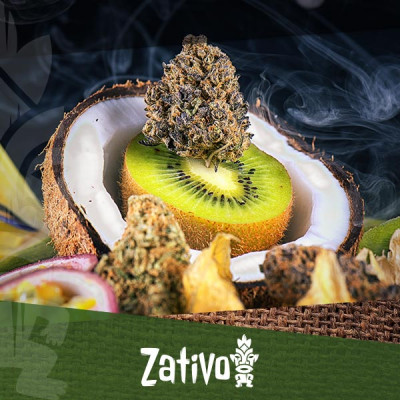Don't have an account?
Register NowYou have to add to cart at least 5 bottles or any program to make checkout.
- BlogWhat Are Cannabis Terpenes?
What Are Cannabis Terpenes?
Published: July 30th, 2023
Categories:
Cannabis Info
Terpenes continue to attract the attention of cannabis users, cannabis companies, and the media. And while there's a significant body of research dedicated to understanding the unique effects of different terpenes, we're still a long way from drawing concrete conclusions about how terpenes might impact the cannabis plant's overall effects. Keep reading for a comprehensive overview of what cannabis terpenes are, as well as some research regarding their potential effects.
What Exactly Are Terpenes?
The term "terpene" refers to any of a large group of unsaturated hydrocarbons typically found in the essential oils of plants. Female cannabis plants produce resinous flowers covered in small, hair-like glands called trichomes. These trichomes contain the highest concentration of the plant's active compounds, including cannabinoids, terpenes, flavonoids, and more. While terpenes can produce biological effects in the body, they are also responsible for giving cannabis its unique aromas.
Cannabis terpenes can be categorised into two groups, depending on their chemical structure:
• Monoterpenes, which contain 2 isoprene units
• Sesquiterpenes, which contain 3 isoprene units
What Function Do Terpenes Naturally Serve?
There's a lot of speculation about why plants produce terpenes. As seen in other plants, the aromas produced by cannabis likely exist to help attract insects like beetles, ants, moths, butterflies, and ladybugs. These insects may help to spread pollen from male plants to females, as well as serve as predators against common cannabis pests (such as thrips, mites, and aphids). Terpenes may also attract birds, which, when female plants have finished flowering, may help to disperse seeds and further propagate the cannabis species. Finally, the unique aroma of cannabis may help to deter herbivorous animals.
Do Terpenes Get You High?

Outside of their natural functions, studies are beginning to show that terpenes also play a vital role in cannabis’ effects when we smoke, eat, or otherwise consume the plant. While they may not be intoxicating in the same way as THC, studies suggest that terpenes may synergise with cannabinoids to produce altered and/or enhanced effects. This phenomenon, known as the entourage effect, could be key to understanding the cannabis plant's unique effects, and how to use it for recreational, medical, and spiritual purposes.
What Are the Most Common Terpenes in Cannabis?
Different cannabis strains can boast vastly different cannabinoid/terpene concentrations. As such, cannabis strains can vary greatly in terms of their aromas, flavours, and effects. In general, however, the most common terpenes found in cannabis include limonene, pinene, myrcene, linalool, beta-caryophyllene, and humulene.
Keep reading for more info about each of these terpenes and how they might affect your experience using the cannabis plant.
Limonene
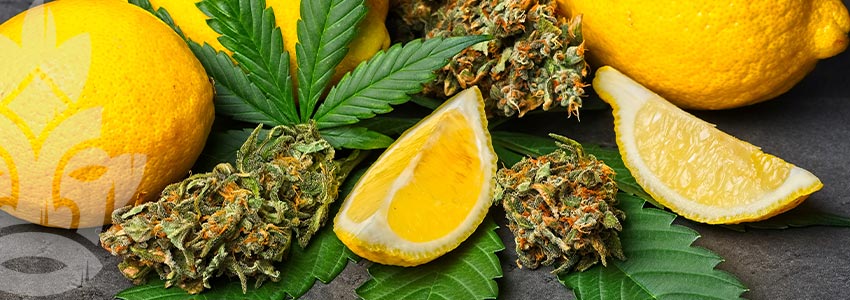
As its name suggests, limonene is often found in lemons and other citrus fruits, especially in the skin—citrus peels can contain up to 95% limonene. However, limonene is also present in dill and caraway, and it contributes to the aroma of many different trees, including maple, spruce, and various pines, firs, and cedar. Limonene is also often used in foods, drinks, cosmetics, perfumes, cleaning products, and botanicals (insecticides and herbicides).
In cannabis, limonene often contributes a fresh, fruity citrus aroma. Some strains that may contain high amounts of limonene include Super Lemon Haze, Sour Orange, Tangie, and more. Always consult laboratory tests for precise information regarding the terpenes and other chemicals in a particular cannabis strain.
Effects
There's a lot of interest surrounding limonene and how it may affect human health. And while many sources claim that the terpene has pronounced therapeutic potential, more research is needed to validate these claims and understand how limonene works on the body. Some purposes for which limonene has been studied include:
• Stress relief and mood enhancement: Studies show that inhaling lemon oil vapor is associated with reduced stress in mice by affecting dopamine and serotonin circuits in the brain.
• Antimicrobial effects: Limonene, along with other essential oils, is widely used in food preparation as a natural preservative. In particular, limonene has been shown to have broad-range antimicrobial properties.
• Inflammation: Animal studies have explored if limonene can reduce signs of inflammation in various cases/scenarios.
• Antitumour effects: Both animal and clinical studies have sought to determine if limonene may affect the growth and spread of tumours.
Pinene
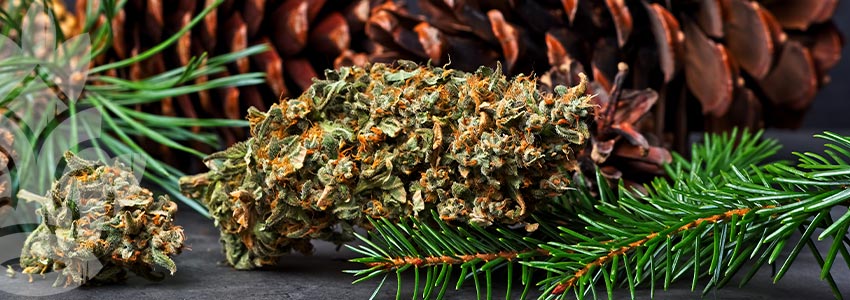
Pinene is the most common terpene in the natural world. It exists in the form of two slightly different chemical structures: alpha-pinene and beta-pinene. Alpha-pinene is most commonly found in cannabis, as well as many other essential oils. It is also one of the main ingredients of turpentine.
Pinene, as its name suggests, has a woody, earthy, and fresh pine-like aroma. It is said to contribute to the unique smell of pine, spruce, and fir trees, though it can also be found in fresh herbs like rosemary, basil, and dill. Pinene is even present in some citrus peels, especially those of lemons and oranges. Cannabis strains believed to be rich in pinene (based on their aroma) include Blue Dream and Northern Lights, among many others.
Effects
Pinene is also appreciated for its potential wellness benefits. So far, research suggests that pinene may:
• Support brain health: Preliminary studies suggest that pinene may have neuroprotective effects. Animal studies, for example, show that treatment with pinene is associated with a reduction in the damage caused by stroke in rats. Researchers attribute this to the anti-inflammatory and antioxidant potential of pinene.
• Relieve stress and improve mood: Several studies suggest that pinene may reduce anxious and depressive behaviours in rodents. Researchers suggest that this may come from pinene's ability to act on serotonin, dopamine, and norepinephrine circuits.
• Relieve pain: Research suggests that pinene may have analgesic effects in animal models of both inflammatory and nociceptive pain. Many of these studies are based on plant extracts or essential oils rich in pinene. Some studies suggest pinene's analgesic potential is comparable to those of pharmaceutical painkillers; one even compares pinene's effects to those of morphine.
• Improve sleep: Animal studies suggest that pinene can enhance sleep in rodents by reducing sleep latency and prolonging REM sleep. This has raised interest in the terpene's potential use as a treatment option for insomnia.
Myrcene
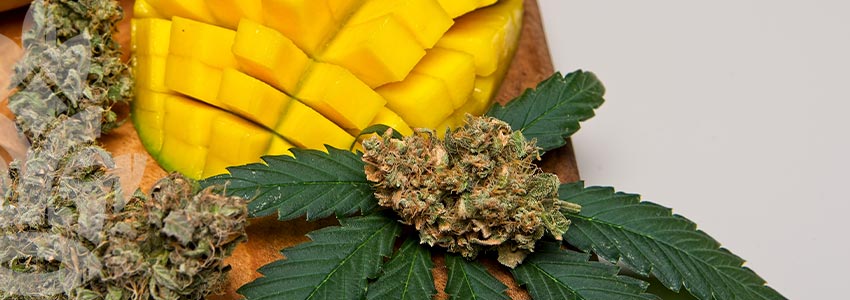
Myrcene is arguably the most common terpene in modern cannabis. It is often used as an aromatic and flavouring agent, particularly in the perfume industry, where it is most commonly used in combination with other compounds to create menthol, citral, and other fragrant chemicals. The myrcene used commercially is generally derived from turpentine rather than sourced naturally, even though it is present in a number of plants, including thyme, lemongrass, bay leaves, juniper berries, and hops. The aroma of myrcene is often described as earthy, piney, and fruity—think of the aromas of a freshly poured pint of hoppy beer.
Effects
Myrcene is believed to contribute to the "couch-lock" effect of some cannabis strains. It is therefore believed to have relaxing or sleep-promoting effects. Research suggests that myrcene may:
• Serve as an analgesic and sedative: Animal studies show that myrcene may reduce nociceptive pain in rodents exposed to hot plate tests, possibly by stimulating the release of endogenous opioids. Other studies show that myrcene (along with citral and limonene) may induce sedative and muscle-relaxant effects in mice. This could be why some myrcene-rich cannabis strains produce strong sleep-promoting or narcotic-like effects.
• Have antimicrobial effects: Rosemary essential oil, which is rich in myrcene, has been shown to have strong antimicrobial and antioxidant effects.
• Have anti-inflammatory properties: In vitro studies of osteoarthritis show that myrcene may reduce the production of nitric oxide (produced at sites of inflammation around the body). The study authors conclude that myrcene also had anticatabolic effects.
NOTE: Some research suggests that myrcene may have antitumour effects. However, based on research from the National Toxicology Program, myrcene was added to California's Proposition 65 for having carcinogenic properties.
Linalool
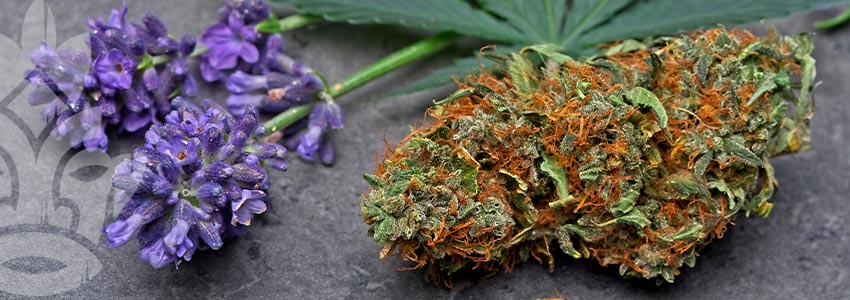
Linalool is another common terpene, found in a wide variety of plants. Boasting a pleasant floral aroma with some slight spiciness (often compared to the soothing aroma of lavender), linalool is also very commonly used in cosmetics, foods, fragrances, and other household items (such as cleaning agents). Linalool is also an ingredient in some insecticides. Besides its upfront floral aromas and flavours, linalool smells somewhat woody and has a citrusy flavour with a spicy accent.
Effects
Apart from cannabis, linalool is also found in basil, roses, and mint, as well as laurels, citrus, and birch trees. Some of the benefits often attributed to linalool include:
• Neuroprotection: In vitro studies of different cases of brain damage show that linalool may have neuroprotective effects, resulting in a reduction of neuron cell death. Some research suggests that this may be due to the fact that linalool and its derivatives can alter inflammatory pathways in the brain.
• Improved cognition: Animal models of Alzheimer's disease showed that rats treated with linalool showed improved learning and memory in cognitive tests (mazes), as well as decreased measures of anxiety. Animal models of stroke produced similar results.
• Anxiolytic effects: Data shows that inhaled linalool may produce anxiolytic effects in mice with similar efficacy as benzodiazepines, yet without deteriorating motor function.
Beta-Caryophyllene
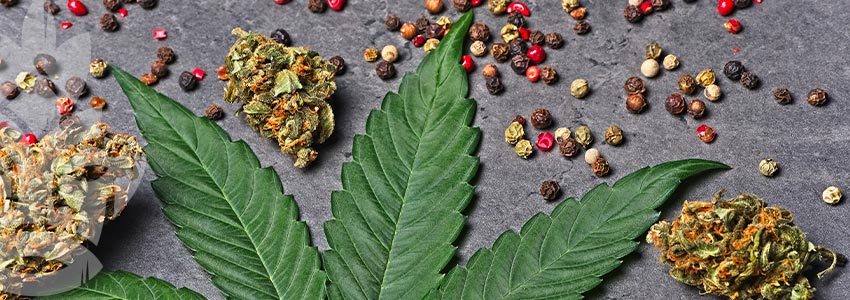
Beta-caryophyllene is arguably the second-most common cannabinoid in modern cannabis. It is one of the few terpenes that's able to interact directly with cannabinoid receptors, and its aroma is warm and spicy, reminiscent of black pepper, cloves, and cinnamon (all of which are rich in beta-caryophyllene). Other plants that contain caryophyllene include hops. rosemary, oregano, and black caraway.
Effects
Studies show that beta-caryophyllene can bind to CB2 receptors and thereby directly affect the functioning of the endocannabinoid system while simultaneously also acting on other biological pathways. Research shows that it may:
• Reduce inflammation: Studies on beta-caryophyllene associate the terpene with reduced measures of chronic inflammation, especially in cases of metabolic or neurological inflammation.
• Alter pain perception: Studies have examined beta-caryophyllene’s ability to reduce neuropathic and inflammatory pain in mice.
• Reduce alcohol intake: Research shows that treatment with beta-caryophyllene reduced voluntary alcohol intake in rats.
• Reduce anxiety and depression: In response to research suggesting that CB2 may play a role in regulating the stress response, as well as symptoms of anxiety and depression, researchers measured the efficacy of beta-caryophyllene in reducing anxious and depressive behaviours in mice.
Humulene
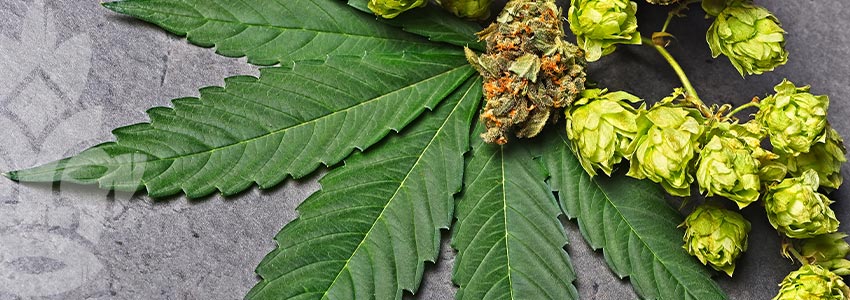
Humulene (also known as alpha-caryophyllene) is an isomer of caryophyllene, meaning it has the same chemical formula but a different molecular structure, which, in turn, gives humulene unique aromas and effects. Humulene was first discovered in the essential oil of hops (Humulus lupulus), but it is also present in many other plants including pine trees, sunflowers, orange trees, and tobacco. In cannabis, it is usually found in lower concentrations than other terpenes, where it may emit a subtle "hoppy" aroma with woody, earthy, and spicy hints.
Effects
Unlike beta-caryophyllene, humulene doesn't act on CB2 receptors. Studies suggest that alpha-caryophyllene helps cannabis plants deter pests, particularly during the later stages of flowering. Moreover, research suggests that humulene may:
• Repel insects: Research from Brazil shows that the essential oil of Commiphora myrrha is effective at repelling yellow fever mosquitoes, particularly thanks to the oil's high concentration of humulene.
• Be effective against bacteria: In 2020, researchers tested humulene's effects against Bacteroides fragilis, a bacteria known to cause inflammatory bowel disease. The study showed that humulene was an effective antibacterial agent.
• Serve as an effective analgesic and anti-inflammatory: Multiple studies have looked into humulene’s effect on inflammation and pain when taken orally, topically, or when inhaled as vapor.
• May affect tumour growth: Studies also show that humulene can produce reactive oxygen species, which, at least at moderate levels, help to control healthy cellular function and regulate cell death. However, moderate or high levels of ROS, have been linked to tumour growth.
Ending on a High Note — Understanding the Complex Nature of Cannabis Terpenes
Cannabis terpenes are a hot topic, and for good reason—research suggests that terpenes are just as important as cannabinoids when it comes to understanding the effects of the cannabis plant.
In this article, we have given you a basic overview of what terpenes are, as well as some general information regarding how they may influence the aromas and effects of cannabis. Note that many of the studies mentioned in this article examined terpenes in isolation and on rats or in vitro. While the findings from these studies are a start, they shouldn't be used to draw full conclusions about how cannabis and the terpenes it contains affect the body. More clinical research using full-spectrum cannabis (rather than terpene isolates) is needed to understand how terpenes, cannabinoids, and other active cannabis compounds may synergise and produce their specific effects.

